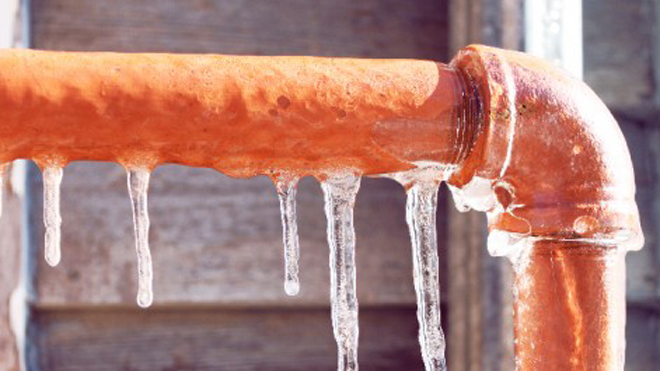Preventing Frozen Plumbing: Best Tips for Winter
Preventing Frozen Plumbing: Best Tips for Winter
Blog Article
The content down the page pertaining to Prevent Frozen Pipes is extremely captivating. Check it out for your own benefit and see what you think of it.

Winter can wreak havoc on your plumbing, especially by freezing pipes. Here's how to avoid it from happening and what to do if it does.
Intro
As temperature levels decline, the threat of frozen pipes boosts, possibly resulting in costly repair services and water damage. Recognizing how to avoid frozen pipelines is essential for house owners in cool environments.
Avoidance Tips
Insulating at risk pipes
Cover pipes in insulation sleeves or utilize heat tape to secure them from freezing temperature levels. Focus on pipelines in unheated or exterior areas of the home.
Home heating techniques
Keep indoor areas adequately heated, specifically locations with pipes. Open up closet doors to enable warm air to flow around pipes under sinks.
Exactly how to identify frozen pipelines
Look for decreased water flow from taps, uncommon smells or sounds from pipelines, and noticeable frost on revealed pipelines.
Long-Term Solutions
Architectural modifications
Think about rerouting pipelines far from outside wall surfaces or unheated locations. Include added insulation to attics, basements, and crawl spaces.
Upgrading insulation
Purchase premium insulation for pipes, attic rooms, and walls. Appropriate insulation helps preserve consistent temperature levels and reduces the danger of icy pipelines.
Shielding Exterior Pipes
Garden hose pipes and outdoor taps
Separate and drain pipes garden pipes before winter months. Install frost-proof spigots or cover exterior taps with shielded caps.
Comprehending Icy Pipes
What triggers pipes to ice up?
Pipelines freeze when subjected to temperature levels below 32 ° F (0 ° C) for prolonged durations. As water inside the pipelines ices up, it expands, putting pressure on the pipe wall surfaces and possibly causing them to break.
Threats and damages
Icy pipelines can lead to water supply disturbances, home damage, and pricey repair work. Burst pipes can flood homes and create substantial architectural damage.
Signs of Frozen Pipeline
Identifying icy pipes early can stop them from breaking.
What to Do If Your Pipes Freeze
Immediate activities to take
If you believe frozen pipes, maintain taps open to alleviate pressure as the ice thaws. Utilize a hairdryer or towels taken in warm water to thaw pipelines slowly.
Final thought
Stopping frozen pipelines needs proactive procedures and quick reactions. By comprehending the reasons, indicators, and preventive measures, property owners can secure their plumbing throughout winter.
6 Proven Ways to Prevent Frozen Pipes and Protect Your Home
Disconnect and Drain Garden Hoses
Before winter arrives, start by disconnecting your garden hoses and draining any remaining water. Close the shut-off valves that supply outdoor hose bibs and leave the outdoor faucet open to allow any residual water to drain. For extra protection, consider using faucet covers throughout the colder months. It’s also important to drain water from any sprinkler supply lines following the manufacturer’s directions.
Insulate Exposed Pipes
Insulating your pipes is an effective way to prevent freezing. Pipe insulation is readily available at home improvement stores and is relatively inexpensive. Pay close attention to pipes in unheated areas such as the attic, basement, crawl spaces, or garage. Apply foam insulation generously to create a buffer against the cold. You can also wrap your pipes in heat tape or thermostat-controlled heat cables for added warmth.
Seal Air Leaks
Inspect your home for any cracks or openings that could let in cold air. Seal any holes around the piping in interior or exterior walls, as well as the sill plates where your home rests on its foundation. Additionally, make sure to keep your garage door closed unless you’re entering or exiting. Leaving it open creates a significant air leak that can lead to frozen pipes.
Allow Warm Air Circulation
During cold snaps, it’s essential to allow warm air to circulate evenly throughout your home. Leave interior doors ajar to promote better airflow. Open kitchen and bathroom cabinets to help distribute heat consistently around the rooms. If you have small children or pets, be sure to remove any household chemicals or potentially harmful cleaners from open cabinets for safety.
Let Faucets Drip
A small trickle of water can make a big difference in preventing ice formation inside your pipes. When temperatures drop significantly, start a drip of water from all faucets served by exposed pipes. This continuous flow helps prevent the water from freezing. Additionally, running a few faucets slightly can relieve pressure inside the pipes, reducing the chances of a rupture if the water inside does freeze.
https://choateshvac.com/6-proven-ways-to-prevent-frozen-pipes-and-protect-your-home/

I'm certainly very fascinated with Prevent Frozen Pipes and I really hope you appreciated our article. If you enjoyed reading our blog entry kindly make sure you remember to pass it around. Many thanks for taking the time to read it.
Explore Report this page